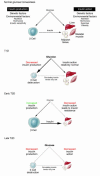Genetic epidemiology of diabetes - PubMed (original) (raw)
Review
Genetic epidemiology of diabetes
M Alan Permutt et al. J Clin Invest. 2005 Jun.
Abstract
Conventional genetic analysis focuses on the genes that account for specific phenotypes, while traditional epidemiology is more concerned with the environmental causes and risk factors related to traits. Genetic epidemiology is an alliance of the 2 fields that focuses on both genetics, including allelic variants in different populations, and environment, in order to explain exactly how genes convey effects in different environmental contexts and to arrive at a more complete comprehension of the etiology of complex traits. In this review, we discuss the epidemiology of diabetes and the current understanding of the genetic bases of obesity and diabetes and provide suggestions for accelerated accumulation of clinically useful genetic information.
Figures
Figure 1
(A) Diabetes trends among adults in the US. *Includes gestational diabetes. Adapted from ref. . (B) Obesity trends among US adults. **BMI ≥ 30 (about 30 pounds overweight for a 5-ft 4-in. individual). Adapted from ref. .
Figure 2
Diabetes results from an imbalance between the insulin-producing capacity of the islet β cell and the requirement for insulin action in insulin target tissues such as liver, adipose tissue. and skeletal muscle. Some of the many genes that have been shown or could possibly contribute to the imbalance are illustrated.
Similar articles
- Genetics of obesity and type 2 diabetes: tracking pathogenic traits during the predisease period.
Bougnères P. Bougnères P. Diabetes. 2002 Dec;51 Suppl 3:S295-303. doi: 10.2337/diabetes.51.2007.s295. Diabetes. 2002. PMID: 12475766 Review. - Genetic epidemiology of obesity.
Yang W, Kelly T, He J. Yang W, et al. Epidemiol Rev. 2007;29:49-61. doi: 10.1093/epirev/mxm004. Epub 2007 Jun 12. Epidemiol Rev. 2007. PMID: 17566051 Review. - [Genetics of human obesity: results from genetic epidemiology studies].
Pérusse L. Pérusse L. Ann Endocrinol (Paris). 2000 Dec;61 Suppl 6:24-30. Ann Endocrinol (Paris). 2000. PMID: 11148333 Review. French. - The thrifty epigenotype: an acquired and heritable predisposition for obesity and diabetes?
Stöger R. Stöger R. Bioessays. 2008 Feb;30(2):156-66. doi: 10.1002/bies.20700. Bioessays. 2008. PMID: 18197594 - The sex-specific genetic architecture of quantitative traits in humans.
Weiss LA, Pan L, Abney M, Ober C. Weiss LA, et al. Nat Genet. 2006 Feb;38(2):218-22. doi: 10.1038/ng1726. Epub 2006 Jan 22. Nat Genet. 2006. PMID: 16429159
Cited by
- Novel avenues of drug discovery and biomarkers for diabetes mellitus.
Maiese K, Chong ZZ, Shang YC, Hou J. Maiese K, et al. J Clin Pharmacol. 2011 Feb;51(2):128-52. doi: 10.1177/0091270010362904. Epub 2010 Mar 10. J Clin Pharmacol. 2011. PMID: 20220043 Free PMC article. Review. - Association of GCK (rs1799884), GCKR (rs780094), and G6PC2 (rs560887) Gene Polymorphisms with Type 2 Diabetes among Malay Ethnics.
Ansari N, Ramachandran V, Mohamad NA, Salim E, Ismail P, Hazmi M, Mat LNI. Ansari N, et al. Glob Med Genet. 2023 Jan 24;10(1):12-18. doi: 10.1055/s-0042-1760384. eCollection 2023 Jan. Glob Med Genet. 2023. PMID: 36703777 Free PMC article. - Chemical chaperones reduce ER stress and restore glucose homeostasis in a mouse model of type 2 diabetes.
Ozcan U, Yilmaz E, Ozcan L, Furuhashi M, Vaillancourt E, Smith RO, Görgün CZ, Hotamisligil GS. Ozcan U, et al. Science. 2006 Aug 25;313(5790):1137-40. doi: 10.1126/science.1128294. Science. 2006. PMID: 16931765 Free PMC article. - Hepatic Bax inhibitor-1 inhibits IRE1alpha and protects from obesity-associated insulin resistance and glucose intolerance.
Bailly-Maitre B, Belgardt BF, Jordan SD, Coornaert B, von Freyend MJ, Kleinridders A, Mauer J, Cuddy M, Kress CL, Willmes D, Essig M, Hampel B, Protzer U, Reed JC, Brüning JC. Bailly-Maitre B, et al. J Biol Chem. 2010 Feb 26;285(9):6198-207. doi: 10.1074/jbc.M109.056648. Epub 2009 Dec 7. J Biol Chem. 2010. PMID: 19996103 Free PMC article. - Glucose tolerance, insulin sensitivity and insulin release in European non-diabetic carriers of a polymorphism upstream of CDKN2A and CDKN2B.
Hribal ML, Presta I, Procopio T, Marini MA, Stančáková A, Kuusisto J, Andreozzi F, Hammarstedt A, Jansson PA, Grarup N, Hansen T, Walker M, Stefan N, Fritsche A, Häring HU, Pedersen O, Smith U, Laakso M, Sesti G; EUGENE2 Consortium. Hribal ML, et al. Diabetologia. 2011 Apr;54(4):795-802. doi: 10.1007/s00125-010-2038-8. Epub 2011 Jan 14. Diabetologia. 2011. PMID: 21234743
References
- Porte, D., Sherwin, R.S., and Baron, A. 2003. Ellenberg & Rifkin’s diabetes mellitus. McGraw-Hill. New York, New York, USA. 1047 pp.
- Zimmet P, Shaw J, Alberti KG. Preventing Type 2 diabetes and the dysmetabolic syndrome in the real world: a realistic view. Diabet. Med. 2003;20:693–702. - PubMed
- Misra A, Vikram NK. Insulin resistance syndrome (metabolic syndrome) and obesity in Asian Indians: evidence and implications. Nutrition. 2004;20:482–491. - PubMed
- Meigs JB, et al. Prevalence and characteristics of the metabolic syndrome in the San Antonio Heart and Framingham Offspring Studies. Diabetes. 2003;52:2160–2167. - PubMed
- Hirsch IB. Blood glucose monitoring technology: translating data into practice. Endocr. Pract. 2004;10:67–76. - PubMed
Publication types
MeSH terms
Grants and funding
- DK049583/DK/NIDDK NIH HHS/United States
- R01 DK049583/DK/NIDDK NIH HHS/United States
- R56 DK049583/DK/NIDDK NIH HHS/United States
- U01 DK058026/DK/NIDDK NIH HHS/United States
- DK58026/DK/NIDDK NIH HHS/United States
LinkOut - more resources
Full Text Sources
Other Literature Sources
Medical

